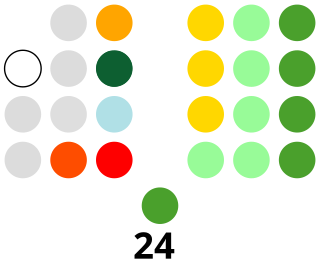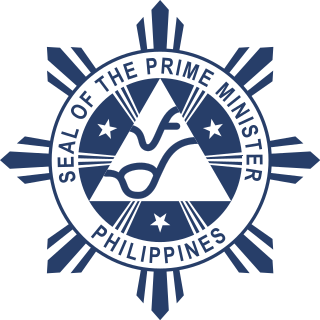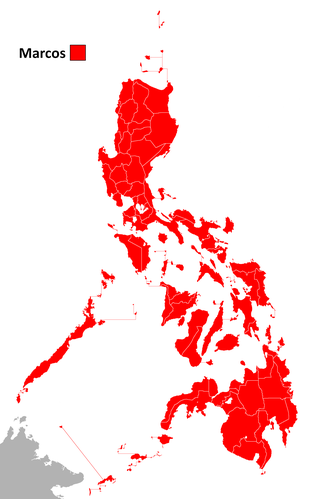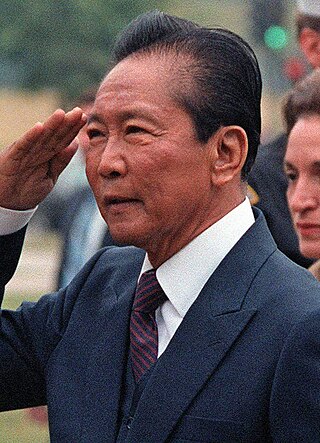| ||
| Adopting the constitution | ||
|---|---|---|
| Calling a plebiscite to ratify the constitution | ||
 |
|---|
The Philippine constitutional plebiscite of 1973 occurred from 10 to 15 January which ratified the 1973 Constitution of the Philippines.
| ||
| Adopting the constitution | ||
|---|---|---|
| Calling a plebiscite to ratify the constitution | ||
 |
|---|
The Philippine constitutional plebiscite of 1973 occurred from 10 to 15 January which ratified the 1973 Constitution of the Philippines.
In 1970, 320 delegates were elected to a constitutional convention which began to meet in 1971. On 23 September 1972, President Ferdinand Marcos issued the formal declaration of martial law which led to the arrests of 11 conveners, alongside government critics and journalists, by the Armed Forces of the Philippines and the Philippine Constabulary. [1] The convention then re-convened and wrote a constitution in line with what President Ferdinand Marcos wanted, at least, according to many critics and victims of martial law.[ citation needed ]
Marcos issued Presidential Decree No. 86 calling for the cancellation of the plebiscite and instituted barangays' citizens' assemblies to ratify the new constitution by a plebiscite from 10–15 January 1973. Alongside the utilization of citizens' assemblies, the voting age was also reduced to 15. Voting in citizens' assemblies took place through viva voce voting, similar to parliamentary procedure, rather than the standard secret ballot that had been used up until that point. [2]
During the course of voting, military men were stationed in prominent positions to intimidate voters. And mayors were given quotas for "yes" votes, while "no" votes were occasionally not recorded. Official figures state that 90% of voters voted in favor of adopting the new constitution, although some communities did not partake in voting. [3]
On 17 January 1973, Marcos issued Proclamation No. 1102 certifying and proclaiming that the 1973 Constitution had been ratified by the Filipino people and thereby was in effect.
These results were challenged during the Ratification Cases heard by the Supreme Court of the Philippine in 1973. The court upheld the results and the ratification of the 1973 Constitution.
| Choice | Votes | % |
|---|---|---|
| | 14,976,561 | 90.67 |
| No | 743,869 | 9.33 |
| Valid votes | 15,720,430 | 78.96 |
| Invalid or blank votes | 4,188,330 | 21.04 |
| Total votes | 19,908,760 | 100.00 |
| Registered voters/turnout | 22,883,632 | 87.00 |
| Source: Proclamation No. 1102, s. 1973 | ||
| Question #1 of the 1973 Philippine constitutional plebiscites results (excluding invalid votes) | |
|---|---|
| Yes 14,976,561 (95.3%) | |
| ▲ 50% | |
| Choice | Votes | % |
|---|---|---|
| | 14,298,814 | 90.96 |
| Yes | 1,421,616 | 9.04 |
| Valid votes | 15,720,430 | 78.96 |
| Invalid or blank votes | 4,188,330 | 21.04 |
| Total votes | 19,908,760 | 100.00 |
| Registered voters/turnout | 22,883,632 | 87.00 |
| Source: Proclamation No. 1102, s. 1973 | ||
| Question #2 of the 1973 Philippine constitutional plebiscites results (excluding invalid votes) | |
|---|---|
| No 14,298,814 (91%) | |
| ▲ 50% | |

The Congress of the Philippines is the legislature of the national government of the Philippines. It is bicameral, composed of a lower body, the House of Representatives, although colloquially the term "Congress" commonly refers to just the latter, and an upper body, the Senate. The House of Representatives meets in the Batasang Pambansa in Quezon City while the Senate meets in the GSIS Building in Pasay.
Elections in the Philippines are of several types. The president, vice-president, and the senators are elected for a six-year term, while the members of the House of Representatives, governors, vice-governors, members of the Sangguniang Panlalawigan, mayors, vice-mayors, members of the Sangguniang Panlungsod/members of the Sangguniang Bayan, barangay officials, and the members of the Sangguniang Kabataan are elected to serve for a three-year term.

The prime minister of the Philippines was the official designation of the head of the government of the Philippines from 1978 until the People Power Revolution in 1986. During martial law and the fourth republic, the prime minister served as the head the Armed Forces of the Philippines. A limited version of this office, officially known as the President of the Council of Government, existed temporarily in 1899 during the First Philippine Republic.

The 1981 Philippine presidential election and national referendum was held on June 16, 1981. President Ferdinand E. Marcos of the Kilusang Bagong Lipunan (KBL) defeated retired general and World War II veteran Alejo Santos of the Nacionalista Party in a landslide victory. Most opposition parties boycotted the election as a sign of protest over the 1978 election for the Interim Batasang Pambansa, which they condemned as fraudulent. At the same time, a national referendum was held on the question in holding elections for barangay elections in 1982.

A parliamentary election was held in the Philippines on April 7, 1978, for the election of the 165 regional representatives to the Interim Batasang Pambansa. The elections were participated in by the leading opposition party, the Lakas ng Bayan (LABAN), which had twenty-one candidates for the Metro Manila area while the leading candidate was the jailed opposition leader Ninoy Aquino, and the Marcos regime's party known as the Kilusang Bagong Lipunan (KBL), which was led by the then-First Lady Imelda Marcos. Ninoy was allowed to run by his fellow partymates under the Liberal Party, who boycotted the election and was not allowed to campaign, and so his family campaigned for him. The night before the election on April 6, 1978, a noise barrage was organized by the supporters of (LABAN) which occurred up to dawn.
A constitutional convention was called to change the 1935 Constitution of the Philippines, written to establish the Commonwealth of the Philippines. A special election was held on November 10, 1970 to elect the convention's delegates, which would convene in 1971.
A constitutional plebiscite was held in the Philippines on 2 February 1987. The plebiscite is pursuant to Presidential Proclamation No. 3 which was issued on 25 March 1986 by President Corazon Aquino. It abolished the Office of the Prime Minister and the Regular Batasang Pambansa. Multi-party elections were held accordingly in 1987.
The 1973 Philippine martial law referendum was a national referendum in which the citizens' assemblies voted for:
A national referendum-plebiscite was held on October 16–17, 1976 in the Philippines in which the majority of the barangay voters approved the continuation of Martial Law and ratified the proposed amendments to the Constitution substituting the Regular Batasang Pambansa with the Interim Batasang Pambansa, pursuant to Presidential Decrees Nos. 991, 1031, and 1032.

The Ratification Cases, officially titled as Javellana v. Executive Secretary, was a 1973 Supreme Court of the Philippines case that allowed the 1973 Philippine Constitution to come into full force, which led to President Ferdinand Marcos staying in office and ordered by decree until he was ousted by the People Power Revolution in 1986. The decision became the cornerstone of subsequent decisions whenever the validity of the 1973 Constitution was questioned.
The Constitution of the Philippines is the constitution or the supreme law of the Republic of the Philippines. Its final draft was completed by the Constitutional Commission on October 12, 1986, and ratified by a nationwide plebiscite on February 2, 1987.

Martial law in the Philippines refers to the various historical instances in which the Philippine head of state placed all or part of the country under military control—most prominently during the administration of Ferdinand Marcos, but also during the Philippines' colonial period, during the second world war, and more recently on the island of Mindanao during the administrations of Gloria Macapagal Arroyo and Rodrigo Duterte. The alternative term "martial law era" as applied to the Philippines is typically used to describe the Marcos martial law period specifically.

Calixto Oirola Zaldivar was a Filipino lawyer and politician who was a Supreme Court Justice from 1964 to 1974 best known in Philippine history for being one of only four dissenting voices against the constitutionality of the Philippines' 1973 constitution in the 1973 case known as Javellana v. Executive Secretary, despite pressure by the authoritarian government of Ferdinand Marcos to vote in the constitution's favor.

The 1969 Philippine presidential and vice presidential elections were held on November 11, 1969. Incumbent President Ferdinand Marcos won a second full term as President of the Philippines. Marcos was the last president in the entire electoral history of the Philippines who ran for and won a second term. His running mate, incumbent Vice President Fernando Lopez, was also elected to a third full term as Vice President of the Philippines. A total of twelve candidates ran for president, but ten of those got less than 0.01% of the vote.
Elections for the House of Representatives of the Philippines were held on November 11, 1969. Held on the same day as the presidential election, the party of the incumbent president, Ferdinand Marcos's Nacionalista Party, won a majority of the seats in the House of Representatives.
1973 in the Philippines details events of note that happened in the Philippines in the year 1973.

The Philippine Constitutional Convention of 1971 was called to change the 1935 Constitution of the Philippines. The delegates were elected on November 10, 1970, and the convention itself was convened on June 1, 1971. It was marked by controversies, including efforts to uphold term limits for incumbent President Ferdinand Marcos, and a bribery scandal in which 14 people, including First Lady Imelda Marcos, were accused of bribing delegates to favor the Marcoses.

Ferdinand Marcos' second term as President of the Philippines began on December 30, 1969, as a result of his winning the 1969 Philippine presidential election on November 11, 1969. Marcos was the first and last president of the Third Philippine Republic to win a second full term. The end of Marcos' second term was supposed to be in December 1973, which would also have been the end of his presidency because the 1935 Constitution of the Philippines allowed him to have only two four-year terms. However, Marcos issued Proclamation 1081 in September 1972, placing the entirety of the Philippines under Martial Law and effectively extending his term indefinitely. He would only be removed from the presidency in 1986, as a result of the People Power Revolution.
Referendums in the Philippines are occasionally held at a national, regional or local level. Referendums can either by national or local in scope. In the Philippines, "referendums" and "plebiscites" mean different things.

A provisional revolutionary government was set up in the Philippines following the People Power Revolution which ended on February 25, 1986. The revolution removed President Ferdinand Marcos, who ruled as a dictator, from office and installed Corazon Aquino as the new president of the country.